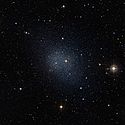Fornax-Zwerggalaxie
| Galaxie Fornax-Zwerggalaxie | |
|---|---|
 | |
| Bild der Fornax-Zwerggalaxie | |
| AladinLite | |
| Sternbild | Chemischer Ofen |
| Position Äquinoktium: J2000.0, Epoche: J2000.0 | |
| Rektaszension | 02h 39m 59s[1] |
| Deklination | -34° 26′ 57″ [1] |
| Erscheinungsbild | |
| Morphologischer Typ | dE2 [2] |
| Helligkeit (visuell) | +9,3 mag [2] |
| Physikalische Daten | |
| Zugehörigkeit | Lokale Gruppe [2] |
| Rotverschiebung | (1.63 ± 0.30) · 10−4 [1] |
| Radialgeschwindigkeit | (49 ± 9) km/s [1] |
| Entfernung | 450.000 Lj |
| Geschichte | |
| Entdeckung | Harlow Shapley |
| Entdeckungsdatum | 1938 |
| Katalogbezeichnungen | |
| PGC 10093 • ESO 356-04 • MCG -06-07-001 • | |
Die Fornax-Zwerggalaxie (Katalogbezeichnungen ESO 356-04 und MCG -06-07-001) ist eine kleine elliptische Galaxie (Typ dE2) im Sternbild Chemischer Ofen (Fornax). Sie gehört zur Lokalen Gruppe und ist eine der Satellitengalaxien der Milchstraße.
Eigenschaften
Die Fornax-Zwerggalaxie ist nur 450.000 Lichtjahre entfernt und hat eine Helligkeit von +9,3 mag. Wegen ihrer sehr geringen Flächenhelligkeit wurde die Fornax-Zwerggalaxie erst 1938 von Harlow Shapley auf fotografischen Platten entdeckt. Dazu benutzte er ein 24-Zoll-Spiegelteleskop am südafrikanischen Boyden Observatory. Obwohl die Zwerggalaxie am Nachthimmel den zweifachen Durchmesser des Vollmondes, also eine Breite von etwa 1 Winkelgrad aufweist, kann sie mit dem Teleskop nicht visuell beobachtet werden. Erst auf langbelichteten Fotografien wird sie sichtbar.
Die Zwerggalaxie enthält sechs Kugelsternhaufen. Der größte darunter, NGC 1049, wurde noch vor der Galaxie selbst entdeckt.
Eine bedeutende Anzahl der Sterne von Fornax ist älter als 10 Milliarden Jahre; in einer Epoche vor 3–4 Milliarden Jahren kam es zu einer erneuten starken Sternentstehung.[3]
Galerie
- (c) ESO/Digitized Sky Survey 2, CC BY 4.0
Eine Aufnahme des ESO Digitized Sky Survey 2 aus dem Jahr 2010
Weblinks
Einzelnachweise
- ↑ a b SIMBAD Database.
- ↑ a b c SEDS.
- ↑ Coleman, Matthew G.; de Jong, Jelte T. A.: A Deep Survey of the Fornax dSph. I. Star Formation History, bibcode:2008ApJ...685..933C.
Auf dieser Seite verwendete Medien
(c) ESO/Digitized Sky Survey 2, CC BY 4.0
The Fornax dwarf galaxy is one of our Milky Way’s neighbouring dwarf galaxies. The Milky Way is, like all large galaxies, thought to have formed from smaller galaxies in the early days of the Universe. These small galaxies should also contain many very old stars, just as the Milky Way does, and a team of astronomers has now shown that this is indeed the case. This image was composed from data from the Digitized Sky Survey 2.
Caption from NASA: Like early explorers mapping the continents of our globe, astronomers are busy charting the spiral structure of our galaxy, the Milky Way. Using infrared images from NASA's Spitzer Space Telescope, scientists have discovered that the Milky Way's elegant spiral structure is dominated by just two arms wrapping off the ends of a central bar of stars. Previously, our galaxy was thought to possess four major arms.
This artist's concept illustrates the new view of the Milky Way, along with other findings presented at the 212th American Astronomical Society meeting in St. Louis, Mo. The galaxy's two major arms (Scutum-Centaurus and Perseus) can be seen attached to the ends of a thick central bar, while the two now-demoted minor arms (Norma and Sagittarius) are less distinct and located between the major arms. The major arms consist of the highest densities of both young and old stars; the minor arms are primarily filled with gas and pockets of star-forming activity.
The artist's concept also includes a new spiral arm, called the "Far-3 kiloparsec arm," discovered via a radio-telescope survey of gas in the Milky Way. This arm is shorter than the two major arms and lies along the bar of the galaxy.
Our sun lies near a small, partial arm called the Orion Arm, or Orion Spur, located between the Sagittarius and Perseus arms.Fornax Dwarf galaxy by GALEX








